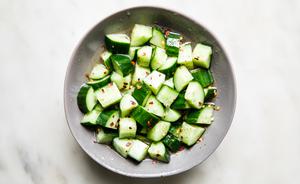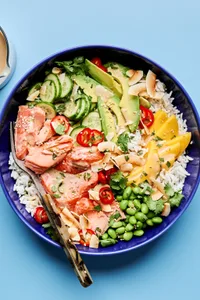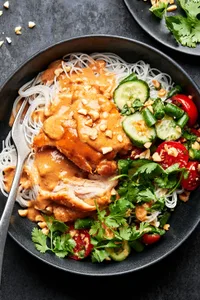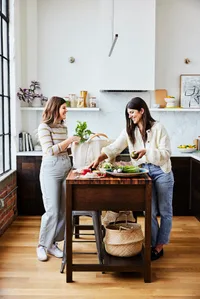A Healthy, Easy Homemade Poke Bowl Recipe
Making a colorful, fresh, salmon and ahi poke bowl at home is pretty darn impressive! It’s also so healthy, and pretty easy. You’ll need a bit of time — like any bowl recipe, poke bowls are made up of lots of little components and sauces— and you’ll need access to really great, high-quality raw fish. Ahi tuna and fresh salmon are the poke bowl fish combo we love most—but you don’t have to live close to a fancy store for that. If you can access the internet, you’ve got access to sushi-grade fish. As for what else goes on a poke bowl? The reason it’s pretty easy to make a poke bowl at home is that many of our toppings are simple (cool, sweet mango, or a fresh, quick Asian Cucumber Salad) or can be store bought (like the seaweed salad). Trust us, you can DIY a poke bowl! If you need a fully cooked bowl recipe, check out our delicious Miso Salmon Rice Bowl.

What Is a Poke Bowl?
True Hawaiian poke can be traced back to a simple dish of raw fish massaged with seaweed, sea salt and sometimes kukui nuts enjoyed by ancient Hawaiians, and in fact, the word “poke” (pronounced POH-KAY) means “to slice” in the Hawaiian language. The arrival of immigrants from China and Japan brought ingredients like sesame oil and soy sauce to Hawaiian poke, and slowly the simple, seasoned dish of raw fish evolved into what we know as poke today. Always enjoyed on the islands, poke’s popularity skyrocketed in the ‘70s, and ahi shoyu (tuna-soy sauce) poke is probably the most popular of all. Serving poke over a bed of rice — the simplest form of a poke bowl — was a no-brainer way to make the seasoned raw fish into a much more filling dish. Thus, the poke bowl!
Today, people top their poke bowls with all kinds of wild things, but there’s almost always a mound of white rice, fresh, seasoned raw fish, and usually some avocado, and often another veggie or two. However, like all bowl recipes, poke bowls are pretty adaptable—it’s OK to play around a bit and see what poke bowl toppings you like best! Poke bowls are a treat, so take your time and make it special. We highly recommend serving these to friends! They’ve got a major wow factor, and who doesn’t want to be reminded of a Hawaiian vacation?


Are Poke Bowls Healthy?
Yes, poke bowls are healthy. They include lots of healthy fats from the fish, and are usually topped with other good-for-you things like veggies, avocado and seaweed meaning that a poke bowl is a pretty darn healthy choice. Poke bowl dressings are usually relatively light, too. Even the mayo-based poke bowl sauces—like the one in our poke bowl recipe—are used in moderation. We love that poke bowls are really filling, too. And if you’d really like to make your poke bowl even healthier, swap the white rice for brown rice for a major nutritional upgrade.


Poke Bowl Ingredients
What comes in a poke bowl? Well, poke bowls are having a majorly trendy moment, which means that people are going bonkers with their poke bowl toppings. Many of them are delicious, but they do represent a complete departure from true, authentic Hawaiian poke bowls. Mostly, our poke bowl ingredients keep things pretty traditional. We’ve included a list of optional toppings, though, and if you’d like to really load up your bowl, we say go for it! Here are the essential components of a really delicious poke bowl:
- Poke: Aka, seasoned raw fish. We usually make our poke with raw salmon and ahi tuna seasoned with soy sauce, scallions and sesame oil. But if you prefer to use all ahi poke or all salmon poke in your poke bowl, that’s just fine.
- Seasoned white rice: While you could use plain Steamed Rice, we love to add rice vinegar and sesame oil to the cooking water, and give it a little extra oomph.
- More poke bowl toppings: This is where you get to have fun! What can you put in a poke bowl? After poke itself, and some rice — basically anything! We love pickled ginger, cucumber salad, avocado, mango, furikake, seaweed salad are all excellent add-ons!

A Wasabi-Citrus Poke Bowl Sauce
Don’t be scared off by the wasabi here. Even if you’re not a big fan of spicy food, the mayo and lemon juice counteract the sharp heat of the wasabi paste and it makes for a lovely, balanced condiment for finishing the poke bowl. Here’s what’s in our delicious poke bowl sauce:
- Mayonnaise
- Wasabi paste
- Lemon juice
- Sesame oil
- Sugar

How to Make The Best Poke Bowl
Yes, this looks like a lot of steps. Yes, the ingredient list looks long. BUT! If you look closely, we’re using the same ingredients over and over again; sesame oil! Soy sauce! Rice vinegar! Plus, every step is quite simple. Here’s how to make a poke bowl at home:
- Make white rice: Rinse the rice and simmer it, covered, for 18 minutes in water seasoned with rice vinegar, sesame oil and salt. Fluff the rice a bit, then let it sit, covered for another 2-3 minutes until it’s fluffy and all the liquid has been absorbed.
- Make the salmon and ahi poke! Gently stir together the cubed, fresh raw ahi tuna and salmon with soy sauce, green onions, sesame oil, rice vinegar and ginger juice. Set it in the fridge for 15 minutes to let the flavors meld.
- Make the cucumber salad: Stir sliced cucumber with a simple dressing of rice vinegar, sugar, salt, red pepper flakes, and sesame oil.
- Make the creamy wasabi citrus sauce: Just mix the mayo, wasabi, lemon juice, sesame oil and sugar in a bowl until you’ve got a uniform sauce.
- To assemble poke bowls: divide the rice between 4 bowls, top with poke, cucumber salad and any of the desired toppings. Drizzle the bowls with the wasabi citrus sauce.
- If you’re serving a crowd and need more recipes ideas, we think Fresh Spring Rolls make a nice companion to poke bowls.

Tips for Buying “Sushi-Grade” Fish for Poke
Even after you buy really great fish, some of the raw fish safety will depend on you. Keep the fish very cold, and use a super, super clean cutting board and knife. Other than that, here’s a few tips for making sure your fish is safe to consume raw:
- Good to know: Labels like “sushi-grade” or “sashimi-grade” are not regulated. Some totally reputable fish companies will use them to indicate quality, just because those labels have become familiar to consumers, but you cannot trust the label alone. So, how can you be sure that the fish you buy is fresh and safe to enjoy raw? Well....
- Prepare to drop a little $$: Good fish that is safe to eat raw is not cheap. It can’t be. It has to be caught responsibly, frozen on the spot, and kept at very exacting temperatures in order to ensure safety. That’s a lot of work! And that means it’s going to cost. Both salmon and tuna have sustainability issues, too, so high-quality salmon and tuna is just going to be pricey. But that’s OK! It’s a splurge. Poke bowls are a big treat, and that’s great. Treat yourself!
- Buy from a fishmonger you really trust. Find the very best fish shop in your area—maybe it’s the fish counter at a gourmet grocery shop, or maybe it’s a small specialty store—and tell them what you need.
- OR, order fish online! Yep, you can buy fish meant for preparations like homemade poke online. Try the Honolulu Fish Company, Seattle Fish Company or Catalina Offshore Products. Order extra and make ahi aguachile, too!
- And if you fear raw salmon, check out more of our Best Salmon Recipes, which includes a lot of cooked salmon ideas, too.

More Delicious Bowl Recipes
Homemade Poke Bowls? We’ll Be Right Over!
For more recipe inspiration, follow us on Facebook, Instagram, TikTok and Pinterest or order our cookbook. We love when you share your meals. Tag us on Instagram using #themodernproper, and we’d love to hear what you think of this recipe in the comments below. Happy cooking!














